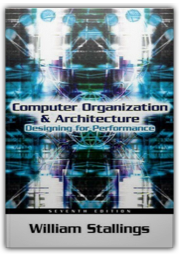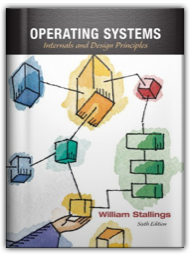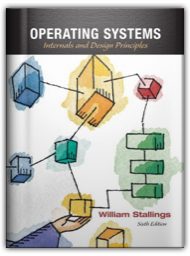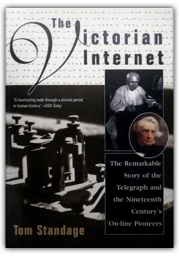
With up-to-date coverage of modern architectural approaches, this handbook provides a thorough discussion of the fundamentals of computer organization and architecture, as well as the critical role of performance in driving computer design. Captures the field’s continued innovations and improvements, with input from active practitioners. Reviews the two most prevalent approaches: superscalar, which has come to dominate the microprocessor design field, including the widely used Pentium; and EPIC, seen in the IA-64 architecture of Intel's Itanium. Views systems from both the architectural and organizational perspectives. Includes coverage of critical topics, such as bus organization, computer arithmetic, I/O modules, RISC, memory, and parallel processors. For professionals in computer product marketing or information system configuration and maintenance. 
This timely revision of an all-time best-seller in the field features the clarity and scope of a Stallings classic. This comprehensive volume provides the most up-to-date coverage of the essential topics in data communications, networking, Internet technology and protocols, and standards – all in a convenient modular format. Features updated coverage of multimedia, Gigabit and 10 Gbps Ethernet, WiFi/IEEE 802.11 wireless LANs, security, and much more. Ideal for professional reference or self-study. For Product Development personnel, Programmers, Systems Engineers, Network Designers and others involved in the design of data communications and networking products. 
Serving as both a basic reference and an up-to-date survey of the state of the art, this book covers the concepts, structure, and mechanisms of operating systems. Stallings presents the nature and characteristics of modern-day operating systems clearly and completely. Updated treatment of Windows as a case study to cover Windows Vista. Online animations with references incorporated throughout. A new chapter on Embedded Operating Systems. Part Six (Distributed Systems and Security) moved online, reducing the cost and size of the book without loss of content. Expanded coverage of security. New figures added, with many existing figures updated to enhance clarity. A useful reference for programmers, systems engineers, network designers and others involved in the design of computer products, information system and computer system personnel. 
Serving as both a basic reference and an up-to-date survey of the state of the art, this book covers the concepts, structure, and mechanisms of operating systems. Stallings presents the nature and characteristics of modern-day operating systems clearly and completely. Updated treatment of Windows as a case study to cover Windows Vista. Online animations with references incorporated throughout. A new chapter on Embedded Operating Systems. Part Six (Distributed Systems and Security) moved online, reducing the cost and size of the book without loss of content. Expanded coverage of security. New figures added, with many existing figures updated to enhance clarity. A useful reference for programmers, systems engineers, network designers and others involved in the design of computer products, information system and computer system personnel. 
Business Data Communications, 6/e, covers the fundamentals of data communications, networking, distributed applications, and network management and security. Stallings presents these concepts in a way that relates specifically to the business environment and the concerns of business management and staff, structuring his text around requirements, ingredients, and applications. All of the material has been updated for the latest technologies and developments in the field, including: specifications of WiFi/IEEE 802.11 wireless LANs, including 802.11n. IP; performance metrics and service level agreements (SLAs); Gigabit Ethernet and 10-Gbps Ethernet standards; New unified communications concepts; expanded, enhanced security material; New online animations illustrate key functions and algorithms in OS design. Appropriate for professionals interested in business data communications. 
Business Data Communications, 6/e, covers the fundamentals of data communications, networking, distributed applications, and network management and security. Stallings presents these concepts in a way that relates specifically to the business environment and the concerns of business management and staff, structuring his text around requirements, ingredients, and applications. All of the material has been updated for the latest technologies and developments in the field, including: specifications of WiFi/IEEE 802.11 wireless LANs, including 802.11n. IP; performance metrics and service level agreements (SLAs); Gigabit Ethernet and 10-Gbps Ethernet standards; New unified communications concepts; expanded, enhanced security material; New online animations illustrate key functions and algorithms in OS design. Appropriate for professionals interested in business data communications. |

Imagine an almost instantaneous communication system that would allow people and governments all over the world to send and receive messages about politics, war, illness, and family events. The government has tried and failed to control it, and its revolutionary nature is trumpeted loudly by its backers. The Internet? Nope, the humble telegraph fit this bill way back in the 1800s. The parallels between the now-ubiquitous Internet and the telegraph are amazing, offering insight into the ways new technologies can change the very fabric of society within a single generation. In The Victorian Internet, Tom Standage examines the history of the telegraph, beginning with a horrifically funny story of a mile-long line of monks holding a wire and getting simultaneous shocks in the interest of investigating electricity, and ending with the advent of the telephone. All the early "online" pioneers are here: Samuel Morse, Thomas Edison, and a seemingly endless parade of code-makers, entrepreneurs, and spies who helped ensure the success of this communications revolution. Fans of Longitudewill enjoy another story of the human side of dramatic technological developments, complete with personal rivalry, vicious competition, and agonizing failures. —Therese Littleton 
When Jeffrey Steingarten was made food critic of Voguein 1989, he began by systematically learning to like all the food he had previously avoided. From clams to Greek food to Indian desserts with the consistency of face cream, Steingarten undertook an extraordinary program of self-inflicted behavior modification to prepare himself for his new career. He describes the experience in this collection's first piece, before setting out on a series of culinary adventures that take him around the world. |

My Library
Collection Total:
1165 Items
1165 Items
Last Updated:
Sep 9, 2009
Sep 9, 2009







 Made with Delicious Library
Made with Delicious Library